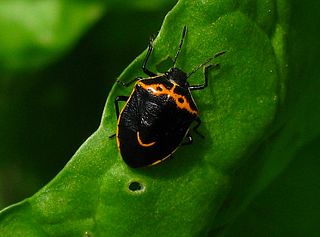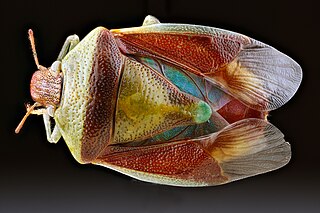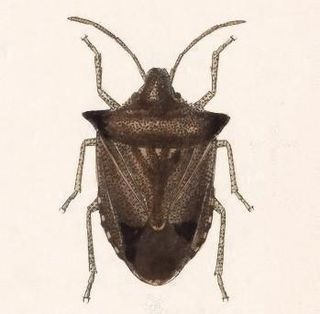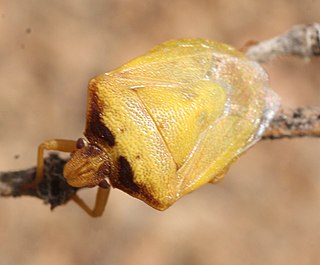
Pentatomidae is a family of insects belonging to the order Hemiptera, generally called shield bugs or stink bugs. Pentatomidae is the largest family in the superfamily Pentatomoidea, and contains around 900 genera and over 4700 species. As hemipterans, the pentatomids have piercing sucking mouthparts, and most are phytophagous, including several species which are severe pests on agricultural crops. However, some species, particularly in the subfamily Asopinae, are predatory and may be considered beneficial.

Pentatominae is a subfamily of Pentatomidae, a family of shield bugs. This subfamily is the largest one within the Pentatomidae, having 4937 species classified in 938 genera. Species in this subfamily are phytophages and several of them are considered agricultural pests. Some invasive pentatomines such as Halyomorpha halys and Bagrada hilaris have been considered household pests. Higher systematics of the group have been revised by Rider et al.

Acanthosomatidae is a family of Hemiptera, commonly named "shield bugs" or "stink bugs". Kumar in his 1974 world revision recognized 47 genera; now this number is 55 genera, with about 200 species, and it is one of the least diverse families within Pentatomoidea. The Acanthosomatidae species are found throughout the world, being most abundant in high-latitude temperate regions and in subtropical regions at high altitudes.

Asopinae are a subfamily of stink bugs. They are predatory stink bugs that are useful as biological control agents against pests, even against other Pentatomid species, which are all herbivorous.

Brochymena is a genus of insects, sometimes known as the rough stink bugs. They belong to the shield bug family, and are easily confused with the similar-looking brown marmorated stink bug.

Cosmopepla conspicillaris is a species of insect in the family Pentatomidae first described by William Dallas in 1851. Due to its common preference for plants in the genus Stachys, it is often called the hedgenettle stink bug. It is also known as the conspicuous stink bug, two-spotted stink bug or happy bespectacled stink bug depending on locality. The name two-spotted stink bug is better applied to another species, Perillus bioculatus.

The brown marmorated stink bug is an insect in the family Pentatomidae, native to China, Japan, Korea and other Asian regions. In September 1998 it was collected in Allentown, Pennsylvania, where it is believed to have been accidentally introduced. The nymphs and adults of the brown marmorated stink bug feed on over 100 species of plants, including many agricultural crops, and by 2010–11 had become a season-long pest in orchards in the Eastern United States. In 2010, in the Mid-Atlantic United States, $37 million in apple crops were lost, and some stone fruit growers lost more than 90% of their crops. Since the 2010s, the bug has spread to the nation of Georgia and Turkey and caused extensive damage to hazelnut production. It is now established in many parts of North America, and has recently become established in Europe and South America.

Alydidae, commonly known as broad-headed bugs, is a family of true bugs very similar to the closely related Coreidae. There are at least 60 genera and 300 species altogether. Distributed in the temperate and warmer regions of the Earth, most are tropical and subtropical animals; for example Europe has a mere 10 species, and only 2 of these occur outside the Mediterranean region.

Cosmopepla lintneriana, the twice-stabbed stink bug, is a species of insect in the family Pentatomidae. Cosmopepla lintneriana was first described in 1798 by Johan Christian Fabricius as Cimex carnifex, and then again in 1865 by Thomas Say as Cosmopepla bimaculata. Cosmopepla lintneriana is hosted by a variety of plants, including milk thistle, echinacea, asparagus, oats, mint and goldenrod, and is widespread throughout North America, from Canada to Mexico. Adult C. lintneriana are black with a red, orange, or yellow band across the pronotum and a short red stripe along the midline, and two red spots at the apex of the scutellum. Nymph coloration ranges from red to white with black markings that change as they grow.

Telenomus podisi is a species of egg parasitoid wasps described by William Harris Ashmead in 1893 and placed in the family of Platygastridae. It is a parasitoid of the brown stink bug, Euschistus heros and can be raised in labs on the eggs of Cosmopepla lintneriana, Podisus maculiventris, and Euschistus servus. This wasp can be used in integrated pest management to control E. heros. The insecticide Imidacloprid is lethal for these wasps, and other insecticides have been shown to negatively impact rates of egg parasitism.

Banasa is a genus of plant feeding stink bugs in the family Pentatomidae.

Euschistus is a genus of stink bugs in the family Pentatomidae. There are at least 20 described species in Euschistus.

Nezarini is a tribe of stink bugs in the family Pentatomidae.

Carpocorini is a tribe of stink bugs in the family Pentatomidae. There are more than 100 genera in Carpocorini.

Dendrocoris is a genus of stink bugs in the family Pentatomidae. There are about 11 described species in Dendrocoris.

Cosmopepla uhleri is a stink bug native to the western regions of the United States, including California and Oregon. It is black with an orange transhumeral band that has black spots. It uses Scrophularia californica as a host.

Thyanta is a genus of stink bugs in the family Pentatomidae. There are about 19 described species in Thyanta.

Thyanta pallidovirens, the red-shouldered stink bug, is a species of stink bug in the family Pentatomidae. It is found in Central America and North America.

Chinavia is a genus of green stink bugs in the family Pentatomidae. There are more than 30 described species in Chinavia.



















